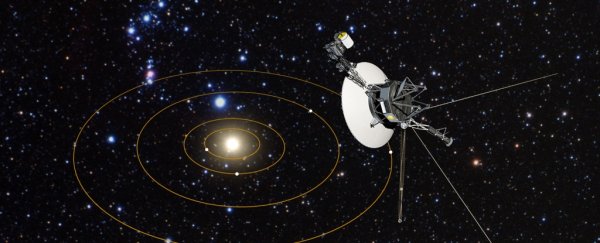In the cold darkness of interstellar space, way past the Kuiper belt, Voyager 1 is continuing its journey out as far from Earth as it can go. Right now, it's over 20 billion kilometres (13 billion miles) from our planet - around 140 times the distance between the Sun and Earth.
And yet we can still communicate with it. Last week, mission scientists from NASA sent instructions to activate backup thrusters that have been dormant for 37 years. And it took 19 hours and 35 minutes for them to hear back from the spacecraft.
"The Voyager team got more excited each time with each milestone in the thruster test. The mood was one of relief, joy and incredulity after witnessing these well-rested thrusters pick up the baton as if no time had passed at all," said JPL propulsion engineer Todd Barber.
For over 40 years, since Voyager 1's launch on 5 September 1977, attitude control has been the work of the main thrusters.
Space is a vacuum, so the craft doesn't need propulsion; but it does need to stay oriented a very specific way for its high-gain antenna to remain pointed at Earth so that we can communicate with it.
This is what the thrusters do. They operate in millisecond pulses - what NASA calls "puffs" - to keep Voyager aligned, with a minute thrust of just 85 grams (3 ounces) for high precision.
But over the course of decades, those thrusters have gradually become degraded to the point that they require more and more puffs to deliver the same attitude adjustments.
This is why, when you're sending something into space where you can never retrieve it for repairs, it's a good idea to include failsafes - in this case, Voyager 1 has additional thrusters that were used for trajectory correction manoeuvres (TCM).
But since the TCM thrusters had been dormant since 1980, the mission team needed to make sure they were still functioning.
"The Voyager flight team dug up decades-old data and examined the software that was coded in an outdated assembler language, to make sure we could safely test the thrusters," said JPL chief engineer Chris Jones.
The TCM thrusters are identical in size and functionality to the attitude control thrusters, but sit at the back of the spacecraft, and were used very differently to the attitude control thrusters.
Rather than using brief puffs, they were deployed in a continuous firing mode. The last time they were needed was 8 November, 1980 - to stay on course when Voyager 1 was flying by Saturn.
To the team's excitement, not only did the TCM thrusters work for attitude control, they worked just as well as the thrusters that had been intended for the purpose.
"With these thrusters that are still functional after 37 years without use, we will be able to extend the life of the Voyager 1 spacecraft by two to three years," said Voyager project manager Suzanne Dodd.
Voyager's thrusters are powered by hydrazine, and there's enough on board to keep them operational until 2040, but we'll probably lose contact with the spacecraft long before then.
Voyager 1's scientific instruments are powered by plutonium, and that's expected to stop generating electricity by around 2023 or so - although it may last up to 2025.
Meanwhile, because the test went so well, the team intends to conduct the same test on Voyager 2, which is expected to enter interstellar space sometime in the next few years.
